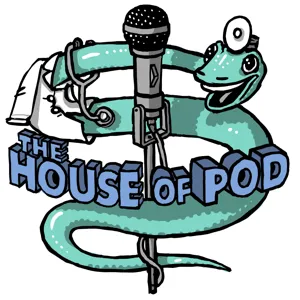Podcast Summary
Connecting with Community for Personal Growth: Building relationships with neighbors, listening to podcasts for encouragement and knowledge, and attending events for opportunities can foster personal growth and preparedness.
Building and strengthening community connections is essential for personal growth and preparedness. Neighbor to Neighbor, a California volunteer network, emphasizes the importance of connecting with neighbors and working together, especially during times of need or natural disasters. Meanwhile, through his podcast, Conversations with UNT, LeDuvall offers words of encouragement and life advice, reminding listeners to never forget to laugh. Additionally, the 2024 Black Effect Podcast Festival provides a platform for aspiring podcasters to pitch their ideas, symbolizing opportunities for growth and innovation. The cattle mutilation panic of the 1970s, as discussed in the Stuff to Blow Your Mind podcast, reveals the sociological significance of unexplained events and the role they play in shaping our anxieties and concerns. Overall, these various examples illustrate the importance of community, growth, and connection in our lives.
Cattle Mutilations: Unexplained Phenomenon in American Cattle Country: The cattle mutilation phenomenon, characterized by surgically precise removal of body parts from livestock carcasses with no signs of blood or scavenger activity, fueled speculation about supernatural or extraterrestrial explanations, but it's important to consider potential causes and the social context in which these beliefs emerged.
The cattle mutilation phenomenon, which emerged in American cattle country during the mid 1970s, involves reports of surgically precise removal of body parts from livestock carcasses, with no signs of blood or scavenger activity. While it's easy to dismiss this as hoax or superstition for those outside of this context, it's worth exploring why this idea emerged and what it reveals about human beliefs and fears. Michael J. Goldman's 2011 paper "Wave of Mutilation" and Bill Ellis's 1989 paper "Death by Folklore" are useful sources for understanding this phenomenon. The reports of mutilations describe clean cuts and absence of usual scavenger species, suggesting something other than natural causes. The lack of blood is also a key feature, fueling speculation about supernatural or extraterrestrial explanations. However, it's important to consider the potential causes behind these beliefs and the social and cultural context in which they emerged.
Misinterpretations of natural phenomena and animal deaths: Historically, misinterpretations of natural phenomena and animal deaths have led to paranormal beliefs and legends.
Cattle mutilations, reports of unusual animal deaths with specific features, have been a subject of mystery and intrigue for decades. These incidents often come with other strange observances, such as aerial phenomena or sightings of unmarked helicopters. While some might attribute these occurrences to extraterrestrial beings, cryptids, or government conspiracies, a more logical explanation could be misinterpretations of natural phenomena or decomposition. Throughout history, misinterpretations of the dead have played a significant role in folklore and superstition. For instance, drowned bodies were once mistaken for vampires in Japan, and human decay was misunderstood in European vampire legends. Similarly, a farmer finding a calf with a hole in its heart might interpret it as a fairy weapon, lacking the necessary knowledge or experience to understand the natural causes. It's important to remember that during situations involving paranormal angles and public panic, people are not always making stupid mistakes. The complexity of these phenomena goes beyond simple misunderstandings.
Cattle mutilations during the 1970s fueled conspiracy theories: The economic instability and distrust of the government during the 1970s led to widespread belief in cattle mutilation conspiracies, despite limited evidence.
During the 1970s, cattle mutilations were a significant concern for many, leading to various interpretations, including supernatural scripts and conspiracy theories. The most prevalent theory was a government conspiracy due to the socioeconomic conditions of the time. Midwestern ranchers, particularly smaller-scale ones, were under immense pressure from factors like stagflation, high food prices, and a global food shortage. President Nixon's price freeze on meat exacerbated the situation, leading to a beef shortage and job losses in the meatpacking industry. This period of economic instability and distrust of the government fueled the belief in cattle mutilation conspiracies. While it's important to consider reasonable explanations for these phenomena, we should also acknowledge the limitations of our knowledge and the potential role of media in shaping perceptions.
Ranchers faced socioeconomic pressures and conspiracy theories during cattle mutilations in the 70s: Ranchers during the 70s experienced economic stress and believed in UFOs or govt conspiracies for unexplained cattle deaths, driven by fear, frustration, and lack of evidence.
During the 1970s, ranchers faced numerous socioeconomic pressures, including inflation and government interference in their industry. This, coupled with their distrust of the federal government, created an anxious and tense environment. The unexplained deaths of cattle during this time fueled conspiracy theories, with many ranchers believing the government was responsible. While some attributed these deaths to UFOs, most reports described strange helicopters in the area. There were also rumors of government conspiracies, including biological weapons tests, which may have contributed to these beliefs. However, it's important to note that there were actual government conspiracies, such as the Dugway sheep incident, which led to dead livestock during this time. Despite this, the widespread belief in cattle mutilations as government-orchestrated events was likely driven more by fear, frustration, and a desire to explain the inexplicable, rather than any concrete evidence.
The Dugway sheep incident and cattle mutilations: The Dugway sheep incident involved sudden deaths of sheep due to nerve agent VX, unlike the theory of government conspiracy behind cattle mutilations which lacks logical explanation for why the government would target private cattle herds at night.
The Dugway sheep incident in Utah, where thousands of sheep were found dead in the late 1950s, could potentially be linked to the theory of clandestine US military testing involving cattle mutilations. However, there are significant differences between the two incidents. In the Dugway incident, there was evidence of nerve agent VX being used, which caused the sheep to die suddenly without any signs of mutilation. On the other hand, the theory of government conspiracy to mutilate cows and horses on ranches and cover it up seems less logical. It's hard to imagine why the government would choose to source cow organs by attacking privately owned cattle herds at night and maintaining secrecy that way, instead of just buying or raising their own stocks. The 1982 film "Endangered Species" explores this conspiracy theory in a thrilling way by keeping the mystery intact and not filling in all the blanks.
Fear and Rumors of Cattle Mutilations: Fear and rumors can lead to dangerous situations and misinformation. Critical thinking and fact-checking are crucial to prevent unnecessary panic and potential harm.
Fear and anxiety can lead to the spread of misinformation and potentially dangerous situations. In the discussed case, rumors of cattle mutilations in certain regions led to the formation of vigilante groups and even encounters with law enforcement. The situation was further fueled by claims of satanic cults being involved, leading to official investigations. However, these investigations ultimately found no evidence to support these claims. This incident highlights the importance of critical thinking and fact-checking in the face of uncertainty and fear. Additionally, the discussion introduced Neighbor to Neighbor, a California volunteers network that aims to help communities grow and prepare for emergencies. The use of Astepro nasal allergy spray was also highlighted as a fast-acting solution for allergy symptoms.
Cattle Mutilations in the 1970s: Debunked: Reports of cattle mutilations in the 1970s were likely due to natural causes or scavenger activity, not supernatural or conspiracy theories. The FBI's non-investigation fueled conspiracy theories, but the lack of evidence and drop-off in reports support the natural explanation.
Despite reports of hundreds or even thousands of cattle mutilations in the 1970s, particularly in the Midwest and Colorado, all evidence suggests that these incidents were most likely due to natural causes or scavenger activity, rather than any supernatural or conspiracy-theory-driven explanations. The FBI's decision not to investigate played into the hands of conspiracy theorists, but the lack of criminal activity and the drop-off in reports by mid-1976 support the theory that these were not unusual occurrences. Cattle death was and still is a common occurrence, with natural causes such as diseases, lightning strikes, and gastrointestinal problems being the most common causes. In 1974, for example, the USDA estimated that 6.1 million cattle deaths had occurred, which was only 4.5% of the overall cattle population. Therefore, finding a dead cow was not an unusual occurrence for ranchers, but when other suspicious reasons were introduced, such as the characteristic features of the injuries, some people continued to believe that something more was going on.
Cattle mutilations might not be supernatural or extraterrestrial: Scavengers and natural processes can explain many cattle mutilation reports, debunking supernatural or extraterrestrial claims
Many reported cases of cattle mutilations may not be the work of supernatural or extraterrestrial forces, but rather the result of natural processes such as scavenging and decomposition. Scavengers like coyotes, foxes, vultures, and magpies often target the soft tissue of deceased animals, leaving behind the "missing" parts that are frequently cited in mutilation reports. Moreover, scavengers can be more precise than one might think, especially when removing soft flesh from a carcass. Additionally, the lack of blood at the scene is not necessarily indicative of an alien or paranormal cause, as it can be attributed to post-mortem coagulation or livor mortis. Decomposition itself can also produce strange and creepy looking injuries on an animal cadaver. Studies have shown that scavenger wounds from decomposing animals can match reported cattle mutilation cases closely. However, some cases may involve human activity, and the motives behind these incidents are still a subject of debate. The idea of satanic cults being involved in cattle mutilations gained popularity during the satanic panic of the late 20th century, but there is little evidence to support this claim. Overall, it is important to approach reports of cattle mundations with a critical and open-minded perspective, considering both natural and paranormal explanations.
Mass hysteria fueled by media sensation and irresponsible law enforcement: The cattle mutilations of the 1970s were likely caused by mass hysteria, fueled by media sensation and irresponsible law enforcement, rather than extraterrestrial activity or government conspiracies.
The cattle mutilations in the 1970s, which were widely believed to be the work of extraterrestrials or a government conspiracy, were more likely the result of mass hysteria fueled by media sensation and irresponsible local law enforcement. Former FBI agent Kenneth Rommel investigated the phenomenon and attributed it to the power of suggestion and disillusionment with American institutions. The lack of experience of local officers in dealing with bovine deaths and their suggestion of the "cattle mutilation script" led to a chain reaction of media coverage and hysteria. Despite debunking efforts, conspiracy theories persisted due to the conspiratorial mindset of some people. The rise and fall of reported mutilations coincided with the cattle industry's economic downturn, with small ranchers being the main sources of reports. This case serves as a reminder of how rumors and misinformation can spread and create mass hysteria.
Understanding Cattle Mutilations: Beyond the Confusion: Cattle mutilations are not all the same, and their causes range from natural to unexplained. Legends can provide insights into reality beyond literal events.
The label "cattle mutilations" has led to confusion and the assumption that all cases share the same cause. This grouping of diverse instances of dead animals with various injuries has causes ranging from natural predators and disease to human intervention. Some cases may defy explanation based on our current understanding of physics, leading some to believe in alien or supernatural explanations. However, folklorist Bill Ellis suggests that legends should be seen as "normative definitions of reality," helping us understand what has happened, what is happening, and what will happen, rather than focusing solely on whether or not they describe literal events. By broadening our perspective, we may be able to make more sense of these mysterious cases.
The line between facts and narratives is blurred by our beliefs and interpretations: Our beliefs and interpretations can shape what we consider to be facts, as seen in legends and darker beliefs, such as food tampering and cattle mutilation rumors.
The line between facts and narratives can be blurred, and our beliefs and interpretations of events can shape what we consider to be facts. This concept, known as ostension theory, was first explored in folklore by Linda Degh and Andrew Vasaly, but the idea goes back further to Umberto Eco's "A Theory of Semiotics." Ostension occurs when an object or event is shown as an example of a larger class or narrative. For instance, in folklore, people may engage in "legend tripping," such as searching for Bigfoot or setting foot on railroad tracks, to reinforce their belief in the legend. However, this concept can also lead to darker beliefs, such as food tampering, ritual murder, and cattle mutilation rumors. These beliefs often involve deliberate acts, misinterpreted evidence, and exaggeration, and our interpretation of puzzling evidence in terms of a narrative tradition plays a key role. So, the line between facts and narratives is not always clear-cut, and our beliefs and interpretations can shape what we consider to be facts.
The search for unexplained phenomena can lead to discoveries, but beware of dangerous fictions: Unexplained phenomena can lead to discoveries, but blurring reality with fiction can be harmful, especially when personal identity or worldview is involved. Approach theories with critical thinking to separate fact from fiction.
The search for unexplained phenomena, such as Bigfoot or star jelly, can lead to discoveries, even if they are not what we initially expected. However, the blurring of fiction and reality, as seen in legends about satanic murders and cattle mutilations, can be dangerous. When personal identity or worldview becomes intertwined with these dangerous fictions, there is a greater potential for harm. It's essential to remember that these theories are not just idle fascinations, but can have real-world consequences. For instance, the idea that big ranches were causing cattle mutilations gained traction during the socio-economic setting of the mid-1970s, but it's important to approach such theories with a critical mindset. We invite listeners to share their thoughts, insights, and counterarguments on this topic, as well as any other theories or theories debunked in the podcast. Tune in to Stuff to Blow Your Mind for more intriguing discussions on various topics, including a cattle mutilation film on Fridays. Remember, critical thinking is key to separating fact from fiction.
Building strong community connections: Fostering relationships, acts of kindness, and unity can simplify life and strengthen communities. Neighbor to Neighbor promotes this, while Visible offers a simple wireless plan and Xumo PLAY provides free, endless entertainment.
Building strong connections within your community can help you in various ways, from providing support during everyday needs to preparing for natural disasters. Neighbor to Neighbor emphasizes the importance of fostering these relationships, encouraging acts of kindness and unity. Meanwhile, on a different note, Visible offers a simple and transparent wireless plan for $25 a month, while Xumo PLAY provides free, endless entertainment with no sign-ups or accounts required. These offerings can help simplify aspects of your life, allowing you to focus on strengthening your community bonds. So, whether it's through Neighbor to Neighbor or these entertainment services, remember that small actions can lead to significant improvements in your life and your community. For more information on Neighbor to Neighbor, visit caneighbors.com. To learn about Visible's wireless plans, go to visible.com. And for endless entertainment, start streaming on Xumo PLAY at play.xumo.com or download the app from the Google Play Stores today.






